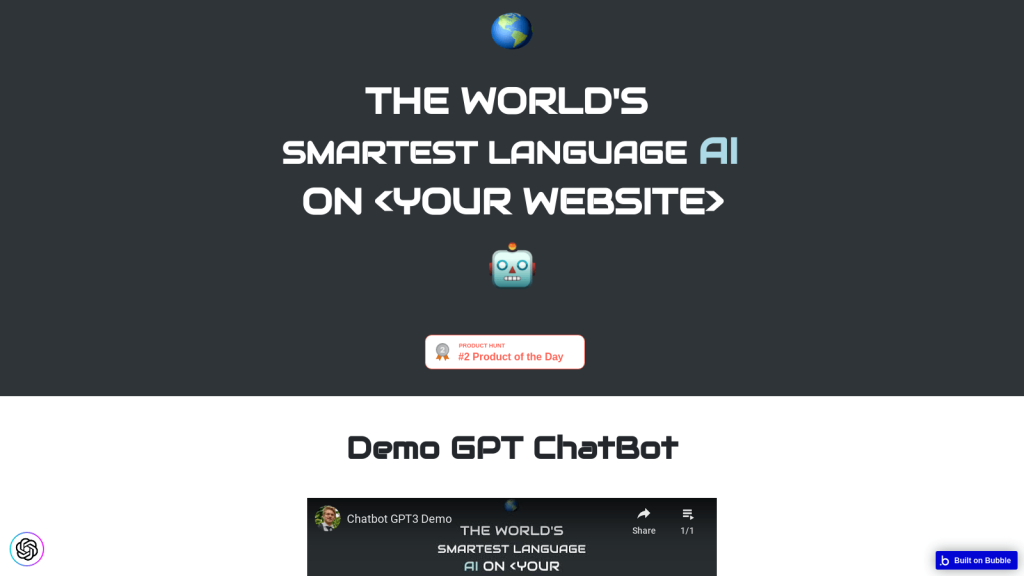What is ChatGPT?
ChatGPT is a highly trained AI language model aimed at producing human-like text related to the input provided. Molded on the GPT-3.5 framework, it makes use of transformer blocks to derive better text comprehension and generation. This has been a revolutionary tool in AI, unknown before, and capable of conducting highly complicated conversations.
Key Features & Benefits of ChatGPT
Equipped with various remarkable features, ChatGPT is a very strong AI system. First, it has an enormous corpus text that it may draw upon to compose responses that are wide-ranging and sophisticated in nuance. In addition, it has a very sophisticated architecture that is entirely based on the GPT-3.5 framework and enhanced with transformer blocks, making it proficient in text comprehension and generation capabilities. It can also reply quickly because of its real-time approach to text processing.
Produces high-caliber outputs claimed to near human conversation; it was rigorously trained for this and has a sophisticated architecture. Versatile applications range from chatbot applications to customer service and content generation. There are several benefits associated with using ChatGPT, including:
-
Efficiency:
More productivity through responses and generation of content by machines. -
Scalability:
Any number of interactions can be handled simultaneously by machines, making them suitable for businesses of any size. -
Quality:
It provides high-quality human-like responses, increasing user engagement and satisfaction.
Use Cases and Applications of ChatGPT
ChatGPT has wide-ranging applications in use cases, as follows:
-
Customer Service:
Builds a customer support system with real-time automated response systems to questions. -
Content Creation:
Allows quick construction of articles, stories, and other creative content. -
Language Translation:
Helps in cross-lingual communication through its quality translation capability. -
Personal Assistant:
Becomes a personal assistant for keeping up with tasks, scheduling, and finding information.
It enables learning through answering questions and explaining concepts across many fields. For instance, in customer support, ChatGPT can be used to respond to inquiries 24 hours a day, which goes a long way to ensure that customers receive information on time and accurately. For the content creators, it can be used to draft ideas and the first drafts; this greatly cuts the time it takes to create quality content.
How to Use ChatGPT
Follow the following steps to use ChatGPT:
-
Access the Platform:
Log on to the service containing ChatGPT. -
Enter Your Prompt:
Type your question or command in the input field. -
Receive Response:
ChatGPT will process your input and give back relevant answers. -
Refine Interaction:
If necessary, provide further input to detail conversation or output.
Tips and Best Practices:
- Be specific with your prompts to get the most relevant responses.
- Use clear and concise language to avoid confusion.
- Try rewording the questions to get different answers from the AI.
The interface is normally always very simple, with one text box to enter your input and another which shows the response.
How ChatGPT Works
ChatGPT is based on GPT-3.5 and uses advanced transformer architecture. Logically, there are a series of transformer blocks that process the text parallelly to give the model the understanding of context and finally come up with a coherent response. The workflow typically follows these steps:
-
Input Processing:
The user’s prompt is tokenized into manageable pieces. -
Model Analysis:
The input tokens are run through a number of layers of the transformer, where it applies learned parameters in generating a response. -
Output Generation:
The model converts this processed data back into natural language text.
From here, ChatGPT has the magic to respond extraordinarily accurately and contextually appropriate in real-time.
Pros and Cons of ChatGPT
Here are some of the benefits and possible disadvantages of the application of ChatGPT:
Benefits:
- Generates human-like quality text.
- The responses are real-time.
- The uses are versatile across different industries.
Possible Drawbacks:
- It can respond nonsensically or inaccurately in certain contexts.
- It requires huge computational resources.
- The ethical concerns around AI usage and data privacy.
In general, users are very complementary to the great abilities of ChatGPT but add that in some instances manual oversight might be necessary to correct flaws.
Conclusion about ChatGPT
In a nutshell, ChatGPT is a very adept language model AI that comes loaded with many features and advantages. It is, therefore, invaluable due to its ability to generate human-like text across industries, from customer service to content creation and beyond. Although some limitations exist, the overall value and potential ChatGPT gives to this tool are hard to resist by those looking to leverage AI in their operations. Further developments assure a bright future for this technology, being able to solidify its place in the AI landscape.
Frequently Asked Questions about ChatGPT
-
What is ChatGPT?
A language model AI based on the GPT-3.5 framework, designed to generate human-like text. -
How does ChatGPT work?
Advanced transformer architecture is used to process and generate text based on the user’s input. -
What are the possible applications of ChatGPT?
This includes customer service, content creation, language translation, personal assistance, and education. -
How much does ChatGPT cost?
From basic for individual users to enterprise for large organizations. -
Do the limitations of ChatGPT exist?
It is very powerful but inaccurate and extremely resource-intensive.










